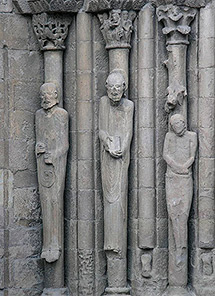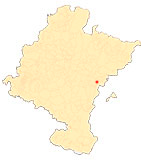The Gateway of Santa María de Sangüesa
By Clara Fernández-Ladreda Aguadé
|
THE ARTISTS. THE WORKSHOP OF SAN JUAN DE LA PEÑA AND THE WORKSHOP OF SCHEMATIC FIGURES |
|
The statues columns
Those to the left of the viewer represent Mary Magdalene, Mary Mother of Christ and Mary of St. James, identified by the inscriptions in the books they carry: Sancta Maria Magdalena, Maria, mater Christi and Maria Iacobi. reference letter They possibly refer to the Resurrection of Christ, which in Romanesque art was usually depicted indirectly through the visit of the three Marys at the empty tomb, an episode which, in turn, alludes to the triumph of the Redemption.
The presence of the Virgin is shocking, as it contradicts the Gospel accounts of the event according to which the third woman was Salome or Joanna, as the case may be (Mk. 16:1 and Lk. 24:10), but it could be explained because some prestigious Christian authors -such as Saint Ambrose- from very early dates maintained that Jesus had appeared first to his mother, which would make her the oldest witness to his resurrection. On the other hand, it should be borne in mind that the church in Sangües is dedicated to the Virgin and that it was customary in Romanesque doorways to include the patron saint of the church, and in a prominent way too.
The ones on the right represent Saint Peter with his typical attribute, the keys - now almost disappeared, but perfectly visible in old photographs -, Saint Paul with his characteristic bald head, and Judas hanging accompanied by the figure of a devil on his head - very deteriorated. As in other works - for example the Moissac façade, where St Peter and St Paul are also present - the two apostles should be placed in relation to the Last Judgement depicted on the tympanum.
On the other hand, the appearance of Judas on a column statue is striking because of its unusual nature, and it is also the figure that has traditionally aroused most interest, giving rise to diverse and contradictory interpretations. Among the most plausible is the one that - based on the reading of the registration engraved on his chest as Iudas mercator, that is, "Judas mercator" - establishes a parallelism between the thieving apostle and the dishonest traders - merchants, This equivalence is set out in the sermon Veneranda dies in the Codex calixtinus or Liber Sancti Iacobi -Codexcalixtinus or Book of St. James-, which is also a possible parallel between the thieving apostle and the dishonest traders -merchants, innkeepers, money changers- who robbed and swindled the pilgrims, threatening them with the same punishment. It is also feasible that the intention is to insinuate a link between Judas and lawbreakers -especially traitors and perjurers-, intimidating them with the same fate, based on the threatening formulas of the legal acts and documents in which this is done, which in turn would connect with a possible function of the title page as framework of judicial processes.












